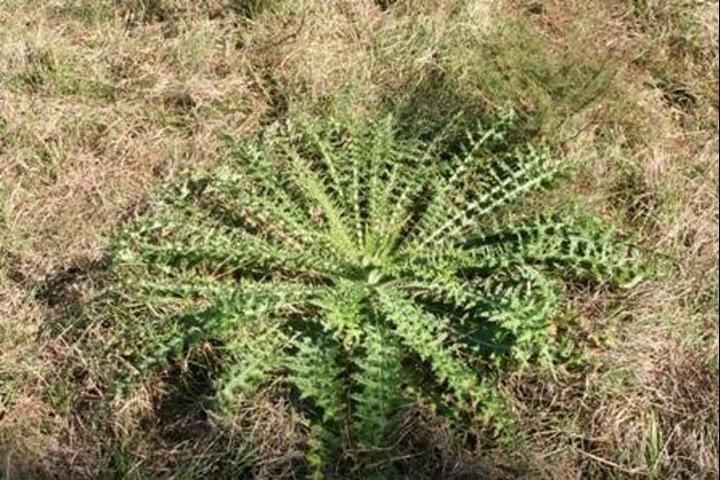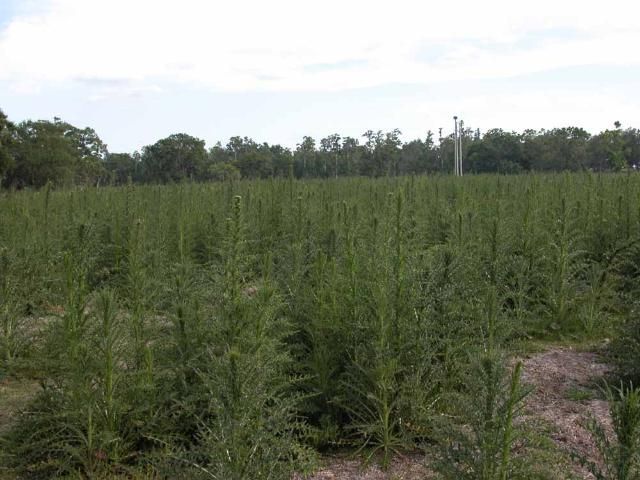If left uncontrolled, thick thistle stands can reduce grazing, result in less forage production, and ultimately lower calf weaning weight. A single thistle plant can produce at least 4,000 seeds, which increases the chance for higher thistle populations in the pasture the following year. Consequently, management practices need to be implemented prior to flower formation for effective thistle control. Even if thistles have not infested your pasture in the past, it is best to scout your pastures in late fall through mid-spring to ensure that thistles do not get out of control. New infestations are easier to manage than large-scale populations.
Although there are at least nine different species of thistle in Florida, most are closely related and control recommendations will not differ. While scouting, you may encounter tall thistle, Le Conte's thistle, swamp thistle, Nuttall's thistle, purple or yellow thistle, bull thistle, Virginia thistle, and possibly others. See the identification key (Table 1) if you are interested in identifying a particular species.
Biology and Control
All thistles mentioned above are biennials, with the exception of Le Conte's thistle, which is a perennial. Biennial plants are those that grow from seed in one year and produce seeds the second year. There are three distinct life stages that pertain to management of thistle. During the first year, the plant will grow as a rosette (a taproot with a cluster of leaves on or near the soil surface) (Figure 1). During the second year, a stalk enlongates (in a process often referred to as bolting) from the rosette (Figure 2). The plant then flowers, produces seed, and dies. In Florida, the rosette growth stage occurs primarily during the winter months. Bolting occurs from late January through July, and flowering occurs from April through August. The variation of growth among individual thistle plants can make control a daunting task.

Credit: B. Sellers, UF/IFAS

Credit: J. Ferrell, UF/IFAS
Mechanical Control
Preventing seed production is of utmost importance when attempting to manage thistle populations. Little can be done to effectively manage these plants if they are allowed to flower and produce seed before control occurs. Small rosettes can be removed by hand by cutting the plant below the soil surface to prevent regrowth. This is not a very practical approach; it is time-consuming and only effective on very small infestations. Mowing thistles can be an effective strategy, but timing is critical. Clipping thistles later in the spring (April to June) is quite effective when the flower stalk is typically hollow (late bolting stage). The plant is not likely to regrow or produce seed if mowed at this time. However, mowing when plants are in the rosette stage (prior to flower stalk formation—bolting) is not effective, and plants will regrow. Therefore, mow only after rosettes have bolted, but before flowers have formed. Timing a mowing treatment can be difficult because all thistles do not bloom at the same time. In addition, rising fuel costs may make mowing an uneconomic thistle control method, especially when multiple mowing treatments are required for effective control.
Chemical Control
Herbicides are often the most flexible and affordable option for thistle control in pastures. However, like mowing, timing is an important factor for many herbicides. Several commonly used pasture herbicides are highly effective on thistles if applied early in the growing season (Table 2). Thistles in the rosette stage are highly sensitive to herbicides and are easily controlled. However, delaying the application until after bolting can have a dramatic impact on effectiveness, particularly with 2,4-D. When applied at flowering, most herbicides provide less than 90% control, except for GrazonNext HL. In this case, using an herbicide may not be warranted, since it can provide short-term control but will not be effective in long-term management. GrazonNext HL will control flowering thistle, but if seeds are already produced and the plant is beginning to die, mowing may be the best (temporary) option. DuraCor, a herbicide that was recently introduced into the pasture market, will provide similar control as obtained with GrazonNext HL.
The importance of application timing cannot be overstated. Thistles are normally not visually evident as a problem until flowers are produced. However, the plants are present in the rosette form long before flowers emerge, and early scouting should facilitate early detection and optimum control. Quickly scouting the pastures in late winter (January to March) will reveal the presence of thistles (rosette stage) and allow for an inexpensive herbicide application. If you wait until thistles flower, mowing and/or herbicide options are limited, less effective, and more expensive. Take the time to scout early, because it is the key to better and more economical thistle control.
Reference
Wunderlin, R. P., and B. F. Hansen. 2003. Guide to the Vascular Plants of Florida. 2nd Ed. Gainesville: University Press of Florida.